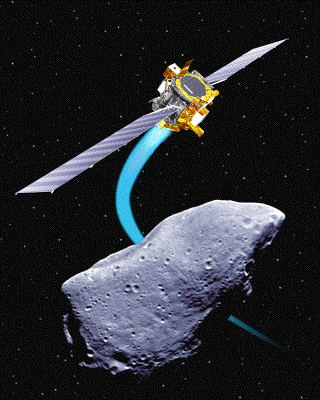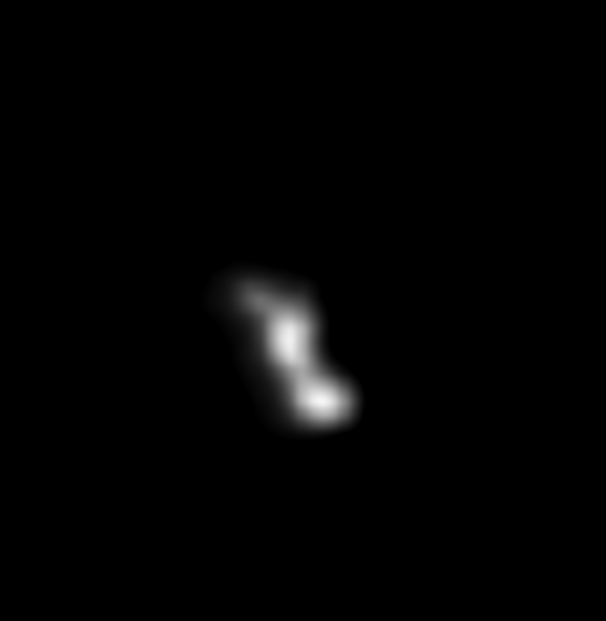






Selected Articles from the
February 2000 Odyssey
Editor: Craig E. Ward
Space Place
A Web Site for Kids
Wondering where to find a good recipe for a tasty solar system snack?
Contemplating a cosmic purpose for an unwanted compact disc (CD)?
Trying to figure out how much yarn it would take to reach an asteroid?
Then look no further than NASA's The Space Place
web site http://spaceplace.jpl.nasa.gov/.
Managed by NASA's Jet Propulsion Laboratory (JPL) in
Pasadena, Calif., this web site provides interesting facts, fun activities
and exciting contests for students in grades K-6.
By logging on, students become active participants in NASA's exciting
space exploration missions through the web site's five categories:
Make Spacey Things; Do Spacey Things; Space Science in Action;
Dr. Marc's Amazing Facts; and Friends Share.
In Make Spacey Things, you can learn how to transform a CD into
a model Saturn decoration, how to cook tasty but scientific asteroid potatoes
and how to create a relief map puzzle of the world. In Do Spacey Things,
you can fall into a black hole, dive below the surface of Mars and participate
in contests to give real names to asteroids or spacecraft.
In Space Science in Action, you can name the trees on earth from
space, make a super sound cone and solve an extraterrestrial riddle. Dr.
Marc's Amazing Facts explains how far spacecraft travels, how planetary
data is transmitted back to Earth and how space telescopes work. For example,
it would take 88,000 tons of yarn to stretch from Earth to asteroid Braille
-- or more than enough yarn to make sweaters for every person in the United
States!
In the Friends Share section, you can view the drawings and goals
for life in the new millennium by others, and see if your local library
or museum is a Club Space Place partner.
The Space Place is updated regularly with puzzles and games, fun
space facts and scientific exercises about the latest breakthroughs and
technology from current and future space missions. The Space Place gives
students the opportunity to fully explore the universe from their computers
or, in some areas, from their local library or museum.
For more information, contact:
Jacob Andrade
(818) 393-5936
jacob.t.andrade@jpl.nasa.gov
Nancy Leon
Education and Public Outreach Lead
NASA New Millennium Program
(818) 354-1067
nancy.j.leon@jpl.nasa.gov
Reading Braille, Part 3
by Robert Gounley
Editors Note: This is the concluding part to the series that began in the October 1999 issue. Images courtesy of NASA/JPL/Caltech.
 Thursday
morning was a time for Deep Space 1’s flight team to reflect. The
day before, we had labored mightily to make certain the spacecraft would
be on course for its planned encounter with asteroid Braille. However,
we could only help so much.
Thursday
morning was a time for Deep Space 1’s flight team to reflect. The
day before, we had labored mightily to make certain the spacecraft would
be on course for its planned encounter with asteroid Braille. However,
we could only help so much.
The cold realities of orbital mechanics dictated that the flyby had to be quick – there were only minutes when high-resolution pictures could be taken. We knew Deep Space 1 (with a little help from its friends) had swept itself past Braille, but had it pointed the camera correctly. Onboard, software should have inspected video images to look for Braille, then calculate where it would have to point next to take another picture. Like a marksman shooting clay pigeons, the spacecraft had to first sight its target, track how it was moving, then pull the trigger at the right times. There were no second chances.
Asteroid Braille was nothing special among Near-Earth asteroids. It was picked for flyby out of convenience and was unlikely to have any characteristic that would entice a second trip to it rather than several dozen other equally worthy candidates. In our lifetimes, all that we were ever likely to learn about asteroid Braille would be known in a matter of hours.
We knew identification was tricky. All that we could tell the spacecraft was that, unlike stars in the camera’s view, Braille would be an “extended object”, taking up several adjacent pixels on an image. There would probably be irregularities casting odd shadows, so the center of the object would be a matter of guesswork. However the biggest problem was that it would be dark. The camera’s optics has had an ongoing problem with stray light, making detection of dark objects difficult. We programmed a threshold we hoped would be low enough to track the asteroid, yet not so low that it would get confused by random signals.
Now, data from that flyby was being sent down to the radio dishes of NASA’s Deep Space Network. Loosely speaking, our travel photos had arrived for processing.
As the pictures “developed”, we saw that picture taking had not gone well. DS1’s onboard software had struggled mightily to track its designated target – if it had been found at all, it was only for fleeting moments. The pictures showed only dark. Anxiously, we watched each new picture compile, but the story did not change. Though we couldn’t see it, we knew each successive picture was being taken when the spacecraft was closer and closer to Braille. Even the one taken from 15k away, the one we secretly hoped would grace the cover of Time magazine turned out black.
Glumly, we waited for the outward-bound pictures to be received and processed.
They would be an inferior view, considerably farther and mostly showing
the asteroid’s dark side with an irregular “crescent” showing
features in the local twilight. Still, it could be good science.
Finally, something appeared on one image, followed by a second, and finally a third. Deep Space 1 had capture three nearly identical pictures from slightly different angles, but from a long distance. Each was no more than a dozen pixels wide. Even when the pictures were combined to approximate better resolution, the result was aesthetically unappealing. It looked like fuzz pulled off of a sweater.
 |
| Image of Braille from DS1. NASA photograph. |
Still, they told us a lot. Not surprisingly, Braille was extremely irregular and its contortions created an ambiguous signal for the camera to aim at. Worse, it was extremely dark – almost at the limits of the camera’s ability to image with the exposure times we had set. From Earth, the brightness of Braille caused us to believe that it was about a mile wide; instead it was a mile and a half wide and darker than coal. We had asked our marksman to shoot a crow on a moonless night.
Time and again we reminded ourselves that this was a low-cost technology mission to test new types of hardware and software. Collecting science data was to be a bonus that we could spare little of our scant resources for. We consoled each other that we had accomplished a lot, but the reassurances felt hollow.
For a year, the flight team had worked cordially together through days, nights, and weekends. Now a few tempers began to fray. There had been many problems that took time away from our encounter planning. “If only we had done more before launch”, the refrains began, “we could have prepared better”, forgetting that we were all working days, nights, and weekends then, too. The grumbles went mostly unanswered. We all hurt a little.
During this gloom, unexpected news raised our spirits. Most of us had forgotten that the camera also doubled as a spectrometer. A few times when it had been programmed to sample Braille’s infrared spectra, it had succeeded. We now had a chemical fingerprint telling us what Braille’s surface was made of.
The minerals themselves were nothing unusual. The fingerprints look much like those of bright asteroids observed from Earth. Based on subtleties in their spectra, these bodies are grouped into “families”. We can say, with confidence, which asteroids had once been joined billions of years earlier.
Braille, we learned, has a big brother. This tiny mountain has a chemical fingerprint almost identical to Vesta, one of the largest asteroids in the Solar System. More importantly, Vesta is a Main Belt asteroid, floating comfortably between the orbits of Mars and Jupiter; Braille is a Near-Earth asteroid whose orbit passes nowhere near Vesta. What clues this may bring to the formation of the Solar System are yet unclear. Even so, Deep Space 1 made a potentially significant discovery.
That’s what really matters.
Copyright © 1998-2003 Organization for the Advancement of Space Industrialization and Settlement. All Rights Reserved.